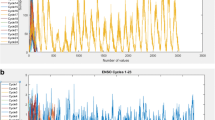Abstract
An active region (AR) of the sun is an area of strong magnetic field. Sunspots are frequently formed in an AR. Solar activity exhibits in the form of solar flares and coronal mass ejections. Solar active region AR12 192 occurring on October 18, 2014 hosted the largest sunspot of the 24th solar cycle which was of the size of Jupiter. AR12 192 was ranked 33rd largest active region out of 32908 active regions since 1874. This study analyzes the complexity and roughness of AR12 192 by studying the hidden persistency. Here persistency will be studied with the help of self-similar fractal dimension. For this purpose two techniques will be used, the Hausdorff-Besicovich box dimension and correlation dimension. The fractal dimension of the image of solar active region AR12 192 will be studied for its persistency. An image is considered to be persistent if the value of Hurst exponent is greater than 0.5. In addition, an analysis is performed using scaling parameters and wave spectrum. In this regard exponents such as scaling exponent, spectral exponent, and autocorrelation coefficient will be particularly studied. Heavy tail analysis for the data relevant to AR12 192 is also performed. A novelty of this study is the application of segmental image analysis using the transformation tools of mathematical morphology such as dilation, erosion, closing and opening to AR12 192.






Similar content being viewed by others
REFERENCES
Addison, P.S., Fractals and Chaos: An Illustrated Course, Boca Raton, FL: CRC Press, 1997.
Ahmadi, B. and Amirfattahi, R., Comparison of correlation dimension and fractal dimension in estimating BIS index, Wireless Sensor Network, 2010, no. 2, pp. 67–73.
A Practical Guide to Heavy Tails: Statistical Techniques and Applications, Feldman, R. and Taqqu, M., Eds., New York: Springer-Verlag, 1998.
Curto, J.J., Blanca, M., and Martínez, E., Automatic sunspots detection on full-disk solar images using mathematical morphology, Sol. Phys., 2008, vol. 250, pp. 411–429. doi 10.1007/s11207-008-9224-6.
Gouriéroux, C. and Jasiaky, J., Truncated Maximum Likelihood, Goodness of Fit Tests and Tail Analysis, CREST Working Paper no. 36, Palaiseau: Center Res. Econ. Stat., 1998.
Grassberger, P., Generalized dimensions of strange attractors, Phys. Lett. A, 1983, vol. 97, no. 6, pp. 227–230.
Grassberger, P. and Procaccia, I., Measuring the strangeness of strange attractors, Phys. D (Amsterdam), 1983a, vol. 9, nos. 1–2, pp. 189–208.
Grassberger, P. and Procaccia, I., Characterizing of strange attractors, Phys. Rev. Lett., 1983b, vol. 50, no. 5, pp. 346–349.
Hanslmeier, A. Denkmayr, K., and Weiss, P., Long-term prediction of solar activity using the combined method, Sol. Phys., 1999, vol. 184, no. 1, pp. 213–218.
Higuchi T., Approach to an irregular time series on basis of the fractal theory, Phys. D (Amsterdam), 1988, vol. 31, pp. 277–283.
Huang, C., Yan, Y., Zhang, Y., Tan, B., and Li, G., The morphologic properties of magnetic networks over the Solar Cycle 23, Astrophys. J., 2012, vol. 759, no. 2.
Mandelbort, B.B., The Fractal Geometry of Nature, New York: Macmillan, 1983.
Matheron, G., Random Set and Integral Geometry, New York: Wiley, 1975.
McAteer, R.T.J., Gallagher, P.T., and Ireland, J., Statistics of active region complexity: a large-scale fractal dimension survey, Astrophys. J., 2005, vol. 631, pp. 628–635.
Moon, K.R., Delouille, V., Li, J.J., De Visscher, R., Watson, F., and Hero, A.O. III, Image patch analysis of sunspots and active regions. I. Intrinsic dimension and correlation analysis, J. Space Weather Space Clim., 2016, vol. 6, art. ID A2. doi 10.1051/swsc/2015044.
Salakhutdinova, I.I., A fractal structure of the time series of global indices of solar activity, Sol. Phys., 1998, vol. 181, no. 1, pp. 221–235.
Serra, J., Image Analysis and Mathematical Morphology, New York: Academic, 1982.
Shanmugavadivu, P. and Sivakumar, V., Fractal dimension based texture analysis of digital images, Procedia Eng., 2012, vol. 38, pp. 2981–2986.
Soille, P., Morphological Image Analysis: Principles and Applications, New York: Springer-Verlag, 2003, 2nd ed.
Stenning, D., Kashyap, V., Lee, T.C.M., van Dyk, D.A., and Young, C.A., Morphological Image Analysis and Its Application to Sunspot Classification, Berlin: Springer-Verlag, 2010.
Zaffar, A., Abbas, S., and Ansari, M.R.K., The probability distributions and fractal dimension of sunspot cycles associated with ENSO phenomena, Arab. J. Geo-Sci., 2018, vol. 11, p. 63. http://doi.org/10.1007/s12517-017-3356-7
Zaffar, A., Abbas, S., and Ansari, M.R.K., An analysis of heavy tail and long-range correlation of sunspot and El Nino-southern oscillation (ENSO) cycles, Solar Syst. Res., 2019, vol. 53, no. 5, pp. 99–103.
Zelenyi, L.M. and Milovanov, A.V., Fractal properties of sunspots, Sov. Astron. Lett., 1991, vol. 17, p. 425.
Author information
Authors and Affiliations
Corresponding authors
Rights and permissions
About this article
Cite this article
Asma Zaffar, Abbas, S. & Ansari, M.R. A Study of Largest Active Region AR12192 of 24th Solar Cycle Using Fractal Dimensions and Mathematical Morphology. Sol Syst Res 54, 353–359 (2020). https://doi.org/10.1134/S0038094620040012
Received:
Revised:
Accepted:
Published:
Issue Date:
DOI: https://doi.org/10.1134/S0038094620040012




